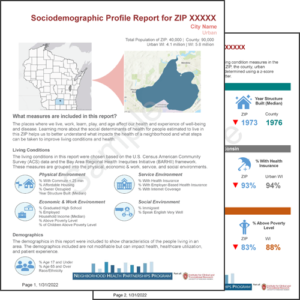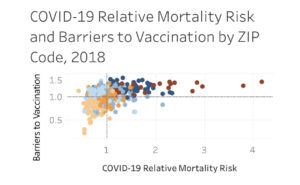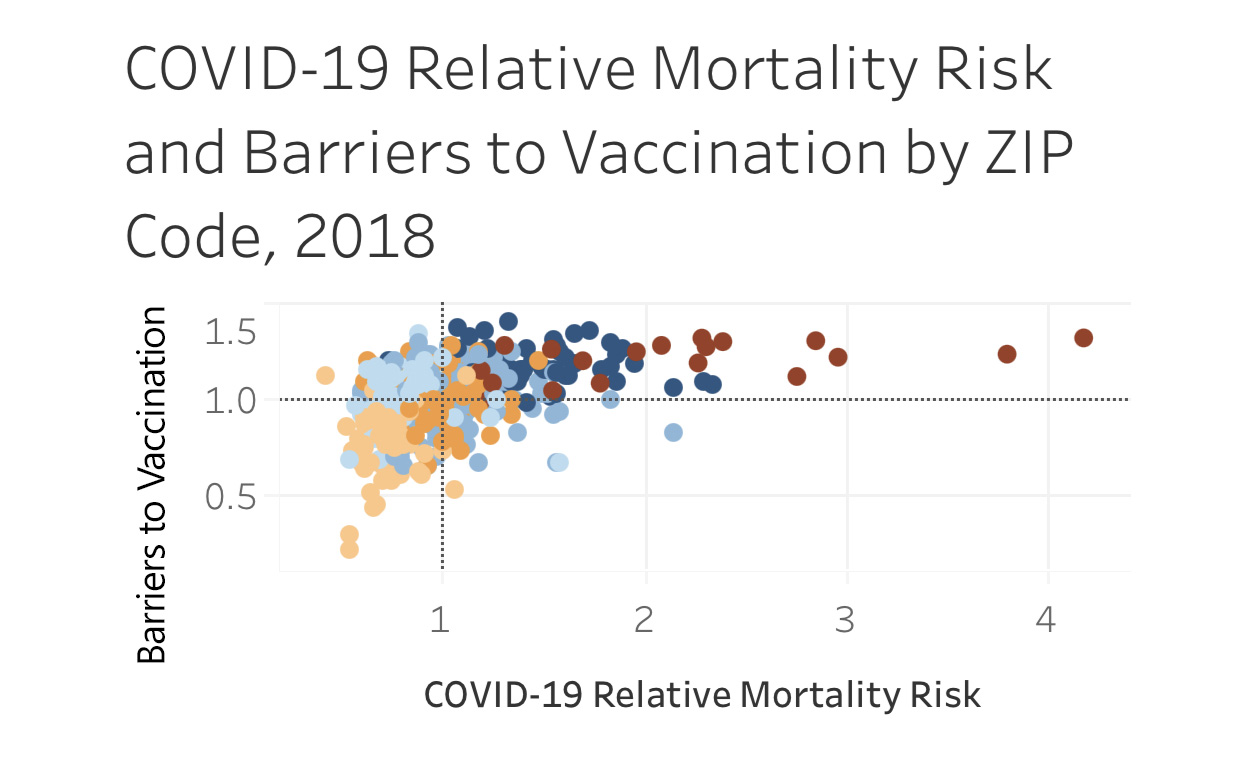New NHP Resources Available Linking Social Determinants of Health with Diabetes and Heart Disease
![]() The Neighborhood Health Partnerships Program recently developed new resources for our "Placing the Social Determinants of Health in Context" series. These tools provide some examples of evidence-informed linkages between diabetes and heart disease and the measures available in the NHP Sociodemographic Profile Reports (e.g., affordable housing, health insurance coverage). NHP is also in the process of developing this tool for additional topic areas (e.g., vaccinations, cancer screenings).
The Neighborhood Health Partnerships Program recently developed new resources for our "Placing the Social Determinants of Health in Context" series. These tools provide some examples of evidence-informed linkages between diabetes and heart disease and the measures available in the NHP Sociodemographic Profile Reports (e.g., affordable housing, health insurance coverage). NHP is also in the process of developing this tool for additional topic areas (e.g., vaccinations, cancer screenings).
The suite of tools for "Placing the Social Determinants of Health in Context" can be found here.
To learn more about NHP reports, visit the website here.
Mental Health tool available on Neighborhood Health Partnerships Program Website
 The Placing Social Determinants of Health in Context: Mental Health tool is now available on the Neighborhood Health Partnerships Program website! These tools were developed to provide examples of evidence-informed linkages between living conditions and health care quality and outcomes.
The Placing Social Determinants of Health in Context: Mental Health tool is now available on the Neighborhood Health Partnerships Program website! These tools were developed to provide examples of evidence-informed linkages between living conditions and health care quality and outcomes.
This tool can be used to help with grant applications, meetings with decision makers and stakeholders, health education efforts, and more! More tools on diabetes, heart disease, cancer screening, and vaccinations are coming soon.
NHP Sociodemographic Profile Report Release
 The UW ICTR Neighborhood Health Partnerships Program (NHP) is excited to announce the launch of our latest ZIP code level report, the Sociodemographic Profile Report.
The UW ICTR Neighborhood Health Partnerships Program (NHP) is excited to announce the launch of our latest ZIP code level report, the Sociodemographic Profile Report.
To make sociodemographic information easily accessible and comparable across geographies, NHP has launched a new report that provides information on the social determinants of health at the ZIP code level. This report uses U.S. Census Bureau American Community Survey (ACS) data to provide additional context about living conditions and demographics for most ZIP codes in Wisconsin.
To view a sample report, click here.
To request a report, click here.
To view examples of how to use NHP reports, click here.
If you would like more information or have feedback, contact the NHP Interim Program Director, Lauren Bednarz at lauren.bednarz@wisc.edu.
New publication available: Using Statewide Electronic Health Record and Influenza Vaccination Data to Plan and Prioritize COVID-19 Vaccine Outreach and Communications in Wisconsin Communities
 The University of Wisconsin Neighborhood Health Partnerships Program used electronic health record and influenza vaccination data to estimate COVID-19 relative mortality risk and potential barriers to vaccination in Wisconsin ZIP Code Tabulation Areas. Data visualization revealed four groupings to use in planning and prioritizing vaccine outreach and communication based on ZIP Code Tabulation Area characteristics. The program provided data, visualization, and guidance to health systems, health departments, nonprofits, and others to support planning targeted outreach approaches to increase COVID-19 vaccination uptake.
The University of Wisconsin Neighborhood Health Partnerships Program used electronic health record and influenza vaccination data to estimate COVID-19 relative mortality risk and potential barriers to vaccination in Wisconsin ZIP Code Tabulation Areas. Data visualization revealed four groupings to use in planning and prioritizing vaccine outreach and communication based on ZIP Code Tabulation Area characteristics. The program provided data, visualization, and guidance to health systems, health departments, nonprofits, and others to support planning targeted outreach approaches to increase COVID-19 vaccination uptake.
Recording available for NHP Lunch & Learn: Local Health Data and Action Tools Resources for Grant Applications

The recording for the Neighborhood Health Partnership’s (NHP) Lunch & Learn: Local Health Data and Action Tools Resources for Grant Applications is now available online. To view the recording, click here.
This lunch & learn showed how to leverage NHP program data on Wisconsin neighborhoods (zip code level) covering 27 health outcomes and care measures spanning the care continuum including wellness, prevention, risk factors for chronic diseases and chronic disease care. Some helpful links from the meeting include:
- ICTR-CAP website https://ictr.wisc.edu/community-academic-research/
- ICTR Consultations https://ictr.wisc.edu/consultations/
- ICTR Funding website https://ictr.wisc.edu/funding-opportunities/
- Neighborhood Health Partnerships Program Website https://nhp.wisc.edu/
- Reports page https://nhp.wisc.edu/reports/
- COVID-19 page https://nhp.wisc.edu/covid-19/
- To request reports/data, email us at nhp@hip.wisc.edu
For questions, please reach out to the following people:
Kate Judge
kjudge@wisc.edu
Lauren Bednarz
nhp@hip.wisc.edu
NHP Hosts Lunch & Learn About Including Local Health Data and Action Tools in Grants

Are you interested in local level data on vaccinations, screenings, blood pressure, heart disease, diabetes, and more for your research? This lunch & learn will show how to leverage ICTR Neighborhood Health Partnership (NHP) program data on WI neighborhoods (zip code level) covering 27 health outcomes and care measures spanning the care continuum including wellness, prevention, risk factors for chronic diseases and chronic disease care. Attendees will also learn about funding opportunities for competitive research proposals through the ICTR Pilot Award Program.
- When: Wednesday, November 17, 12:00-1:00 pm
- Where: Zoom (link will be sent out after you RSVP)
- RSVP: Please let us know you’re coming by clicking HERE
This information session will answer the following questions:
- What data are available and how can health researchers use it? Learn how you can leverage existing data on health outcomes and care measures for YOUR health research.
- What is the Neighborhood Health Partnerships Program (NHP)? Learn about this ICTR-CAP program and the reports and tools they produce and deliver to support research, promote action, and improve health.
- Is there funding available? An overview of the ICTR Pilot Award Program funding opportunities and RFA release dates will be provided. Watch here for updates on ICTR funding opportunities: https://ictr.wisc.edu/funding-opportunities/
Questions? Contact Kate Judge at kjudge@wisc.edu or Lauren Bednarz at lauren.bednarz@wisc.edu
New Publication Available
Co-designing to advance community health and health equity in Wisconsin: Building the Neighborhood Health Partnerships Program
 The Neighborhood Health Partnerships Program (NHP) is a part of the University of Wisconsin Institute for Clinical and Translational Research (ICTR). ICTR exists to create an environment that speeds the translation of research into real-life community practice, paving the way to health improvement. One method of increasing the speed of translating research into practice is engaging communities. Effective engagement requires a shared understanding of community health care quality and outcomes. Creating this shared understanding can be challenging without timely and accurate local health data, or ways to provide the data that are directly applicable to improving community health. NHP offers the promise of shared understanding through accurate local health data, but success is dependent on the adoption of program assets by both researchers and community stakeholders.
The Neighborhood Health Partnerships Program (NHP) is a part of the University of Wisconsin Institute for Clinical and Translational Research (ICTR). ICTR exists to create an environment that speeds the translation of research into real-life community practice, paving the way to health improvement. One method of increasing the speed of translating research into practice is engaging communities. Effective engagement requires a shared understanding of community health care quality and outcomes. Creating this shared understanding can be challenging without timely and accurate local health data, or ways to provide the data that are directly applicable to improving community health. NHP offers the promise of shared understanding through accurate local health data, but success is dependent on the adoption of program assets by both researchers and community stakeholders.
In this publication members of the NHP team discuss how we executed a co-design program with researchers and community stakeholders to build reports, data-to-action tools, and a dissemination model that could be adopted and utilized by all stakeholders in health and health equity improvement efforts.
Planning and Prioritizing COVID-19 Vaccine Outreach and Communications toolkit available on HIPxChange
 COVID-19 vaccination may be off to a slow start, but soon supply levels will rise and processes will be streamlined. Thoughtfully designed outreach with well-crafted messages will be of the utmost importance to ensure enough people are vaccinated to put us on the path to population immunity and long-term protection from the disease. As decision-makers plan and implement vaccination campaigns, understanding the COVID-19 relative mortality risks and potential barriers to vaccine uptake by ZIP code will be valuable in building effective communication and outreach plans in each community.
COVID-19 vaccination may be off to a slow start, but soon supply levels will rise and processes will be streamlined. Thoughtfully designed outreach with well-crafted messages will be of the utmost importance to ensure enough people are vaccinated to put us on the path to population immunity and long-term protection from the disease. As decision-makers plan and implement vaccination campaigns, understanding the COVID-19 relative mortality risks and potential barriers to vaccine uptake by ZIP code will be valuable in building effective communication and outreach plans in each community.
With this in mind, leaders of the UW Neighborhood Health Partnerships Program (NHP) partnered with the Wisconsin Collaborative for Healthcare Quality (WCHQ) and researchers at the UW Health Innovation Program (HIP) to develop a tool that will help community-level decision makers prioritize their COVID-19 vaccination outreach in Wisconsin communities. The tool, available at https://nhp.wisc.edu/covid-19/, estimates the relative risk of COVID-19 mortality and potential barriers to COVID-19 vaccination in many Wisconsin ZIP codes.
Register Now for the February 24 COVID-19 Vaccine Outreach and Communications Webinar
 Using Local Data to Plan and Prioritize COVID-19 Vaccine Outreach and Communications in Wisconsin Communities
Using Local Data to Plan and Prioritize COVID-19 Vaccine Outreach and Communications in Wisconsin Communities
February 24, 2021 | 4:00pm – 4:45pm CST
Featuring: Jessica Bonham-Werling, Director, ICTR Neighborhood Health Partnerships Program
COVID-19 vaccination may be off to a slow start, but soon supply levels will rise and processes will be streamlined. Thoughtfully designed outreach with well-crafted messages will be of the utmost importance to ensure enough people are vaccinated to put us on the path to population immunity and long-term protection from the disease. As decision-makers plan and implement vaccination campaigns, understanding the risk of death (mortality) from COVID-19 and potential barriers to vaccine uptake by ZIP code will be valuable in building effective communication and outreach plans in each community.
With this in mind, UW Neighborhood Health Partnerships Program (NHP) partnered with the Wisconsin Collaborative for Healthcare Quality (WCHQ) and researchers at the UW Health Innovation Program (HIP) to develop a tool that will help community-level decision makers prioritize their COVID-19 vaccination outreach in Wisconsin communities. In this webinar, Jessica Bonham-Werling, Director of NHP and Associate Director of Research Operations at HIP will dive into this innovative new approach.
For more information, contact Jessica Bonham-Werling.
UW researchers develop tool to help prioritize, plan COVID-19 vaccine outreach and communications
 COVID-19 vaccination may be off to a slow start, but soon supply levels will rise and processes will be streamlined. Thoughtfully designed outreach with well-crafted messages will be of the utmost importance to ensure enough people are vaccinated to pave the way to population immunity and long-term protection from the disease.
COVID-19 vaccination may be off to a slow start, but soon supply levels will rise and processes will be streamlined. Thoughtfully designed outreach with well-crafted messages will be of the utmost importance to ensure enough people are vaccinated to pave the way to population immunity and long-term protection from the disease.
With this in mind, leaders of the UW Neighborhood Health Partnerships Program (NHP) partnered with the Wisconsin Collaborative for Healthcare Quality (WCHQ) and researchers at the UW Health Innovation Program (HIP) to develop a tool that will help community-level decision makers prioritize their COVID-19 vaccination outreach in Wisconsin communities. The tool, available at https://nhp.wisc.edu/covid-19/, estimates the relative risk of COVID-19 mortality and potential barriers to COVID-19 vaccination in many Wisconsin ZIP codes. Jessica Bonham-Werling, Director of NHP and Associate Director of Research Operations at HIP spearheaded the effort.
“While public health and health care communicators and marketers have been running flu vaccination campaigns for years, the urgency and importance of getting people vaccinated for COVID-19 will present a new challenge,” according to Bonham-Werling. “We have built a tool that will help target outreach and guide the development of messages that meet specific community needs to motivate people to get vaccinated as quickly as possible.”
The relative risk of COVID-19 mortality for each ZIP code was calculated using electronic health record data, voluntarily provided by over 20 Wisconsin health systems to WCHQ. The team produced a similar analysis earlier in the pandemic, but this update was created using a risk calculator that was recently published by Johns Hopkins University researchers in Nature Medicine based on all the knowledge that has been gained about COVID-19 risk factors. This calculator uses sociodemographic factors and information on pre-existing conditions to predict death from COVID-19.
“Wisconsin health systems and medical clinics are committed to protecting the people living in their communities, but we can’t help those we cannot reach,” according to WCHQ President and CEO Gabrielle Rude, Ph.D. “The fight to beat this virus requires new tools that not only identify areas of the state with people who are most at risk, but that also enable our health systems and public health professionals to develop outreach strategies that help us communicate with those who are hard to reach.”
Potential barriers to COVID-19 vaccination were calculated for each ZIP code using seasonal flu vaccination data from the Wisconsin Department of Public Health. There are many potential barriers to seasonal influenza vaccination, including rates of insurance coverage, access to health care and concern about vaccine safety and efficacy. While there are important distinctions between COVID-19 and seasonal flu vaccination, flu vaccination rates can help health professionals anticipate the challenges ahead and plan accordingly.
The tools were developed by NHP, a part of the UW Institute for Clinical and Translational Research, with funding provided by the Wisconsin Partnership Program.
Website: https://nhp.wisc.edu/
Contact: nhp@hip.wisc.edu

